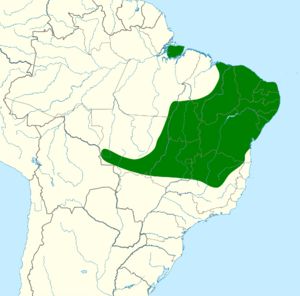Caatinga puffbird facts for kids
Quick facts for kids Caatinga puffbird |
|
|---|---|
 |
|
| A Caatinga puffbird, N. m. maculatus | |
| Conservation status | |
| Scientific classification | |
| Genus: |
Nystalus
|
| Species: |
maculatus
|
 |
|
| Synonyms | |
|
Alcedo maculata (protonym) |
|
The Caatinga puffbird (Nystalus maculatus) is a cool bird that belongs to the Bucconidae family. This family includes puffbirds, nunlets, and nunbirds. You can only find this bird in Brazil, which means it is endemic there.
Contents
About Its Name
Scientists give every living thing a special two-part name. This helps everyone around the world know exactly which animal they are talking about. For the Caatinga puffbird, its scientific name is Nystalus maculatus.
The first part, Nystalus, is its genus name. A genus is a group of very similar species. The second part, maculatus, is its species name. This part often describes something about the animal. In this case, maculatus is a Latin word meaning "spotted" or "blotched," which fits the bird's look!
A German scientist named Johann Friedrich Gmelin officially named this bird in 1788.
What It Looks Like
The Caatinga puffbird is about 18 to 19 centimeters (about 7 to 7.5 inches) long. It weighs between 32 and 38 grams (about 1.1 to 1.3 ounces).
It has a dark brown head with light, buffy spots. Around its neck, at the back, it has a pale reddish-orange collar. Its back and the top parts of its wings are dark brown with buffy spots and stripes. Its long, thin tail has wide black stripes and narrow buffy stripes.
Its face is mostly off-white with darker streaks, and it has a light, buffy stripe above its eye. Its chin is white, and its throat and upper chest are a bright orange-red. The rest of its belly is white with clear black spots on the upper chest and black streaks on its sides.
The bird's bill (beak) is mostly red. Its eyes are pale yellow, and its feet are a brownish-olive color.
When it sings, it makes an up-and-down sound like "tewre-tewtewretewtewre." Sometimes, two or three birds will sing together!
Where It Lives
You can find the Caatinga puffbird in northeastern and central Brazil. It lives in areas called cerrado, caatinga, and campo. These are types of semi-open landscapes.
It likes places like:
- The inside and edges of forests that lose their leaves
- Savannas (grassy plains with scattered trees)
- Palm tree groves
- Areas with shrubs and bushes
- Pastures (fields where animals graze)
Scientists think these birds stay in the same area all year. However, they might move around a bit during different seasons.
How It Behaves
Eating Habits
The Caatinga puffbird is a hunter! It likes to sit on a low branch and then quickly fly out to catch its food. It usually grabs its prey from the ground or from leaves. Its favorite foods are insects, especially caterpillars.
Nesting and Babies
We don't know everything about how the Caatinga puffbird raises its young. But we do know that it builds its nest in a hole. This hole is often in a soil bank or even on flat ground. The nest is lined with leaves to make it cozy. A mother puffbird usually lays two or three eggs.
How Many There Are
The Caatinga puffbird is considered a species of "Least Concern" by the IUCN. This means there are still many of them, and they are not currently in danger of disappearing. They live across a very large area. Even though we don't have an exact count of their population, it seems to be steady. They are quite common where they live.
Gallery





